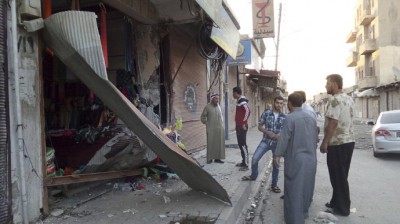War Crimes and the Ghost Children of Homs, Syria

When you walk along these dusty and mostly abandoned streets, the Syrian city of Homs seems like a grim Hollywood set.
The buildings are hollowed out from bombings. Not a single window, not a single door, are untouched by bullets.
See also: Syrian civilians trapped as ISIS launches new offensive
It is hard to fathom how much hatred it must have taken to achieve such destruction, to transform a once-bustling city into an empty shell.

Damaged buildings from fighting in the old city of Homs, Syria, May 8, 2014.
The detritus of war is everywhere. Every caliber has been carved into these walls. From AK bullets to aerial shells, it seems every possible ordinance has been used against this godforsaken city.

This June 5, 2014 photo shows a bullet riddled house in a devastated part of Homs, Syria.
Image: Dusan Vranic/Associated Press
A building looks like it was repaired at some point — during a truce maybe — only to get pounded when hostilities broke out anew, obliterating almost everything above the second floor.
In the rubble of the old town, the cemetery is still intact — as if, in this corner of hell, only the dead have been left in peace.
On the first floor of another building, this one on the corner of a narrow street, a sniper position is left intact. There is his sniper’s chair, his shoe tracks on the dusty floor and the mirror he used to locate his targets before slowly aiming at his kill.
Suddenly, a child’s face appears at the end of a dark corridor. A little girl follows.
Do they know the sniper who, not even a year ago, stood where I stand now? Is he part of their family? Is he still alive?
They look surprised to see me, but, unlike most children I’ve met in the Middle East, don’t ask me anything or taunt me for treats. The children’s silence is unnerving. They look like ghosts — the ghosts of the thousands of children killed in this very city; this neighborhood and its surroundings.
The children don’t smile or utter a single word. They just stand there in the rubble of what was once their home.

A general view of a damaged building in the city of Homs, Syria, 24 June 2014.
Image: EPA/STR
The Syrian civil war has left Homs a shattered shell of the city it once was. As the regime of President Bashar al-Assad cracked down on anti-government protests across the country, Homs became a key battleground. Opposition forces [Al Nusrah, FSA, ISIS] and Syrian government troops fought pitched battles for more than two years as they struggled for control of the city.
In May 2014, the United Nations brokered a peace deal but less than 20% of the population has returned since the fighting stopped. The majority of the city’s residents now live in refugee camps elsewhere.

Syrian civilians carry their belongings next to damaged buildings in Homs, Syria, 10 May 2014
Image: EPA/STR
When I visited Homs a few weeks ago, the governor of Homs, Talal al-Barazi, was trying his best to explain the plans to rebuild the city and bring the residents back.
The neighborhood of Bab Amr, where the journalists Mary Colvin and Rémi Ochlik were killed in a shelling three years ago, had been reimagined as a thriving urban environment.
Today, it lies in ruins.

A general view shows the destruction at the entrance of Hamidiya market in the old city of Homs, Syria, 08 May 2014.
“We are trying to find solutions,” al-Barazi says. “If a terrorist wants to lay down his weapons, he will be reintegrated.”
Despite the historic resilience of devastated cities such as Beirut, Sarajevo and Dresden, it is hard to imagine Homs coming to life again. Indeed, in light of renewed fighting, Homs risks becoming the new frontline in the battle for the capital of Damascus.
“Daesh won’t come here,” one local shopkeeper told me, referring to the ISIS militants.
“The war is over for us,” he said, wanting it so much to be true.

In this June 5, 2014 photo, a man rides a bicycle through a devastated part of Homs, Syria.Image: Dusan Vranic/Associated Press

